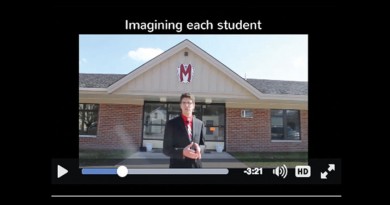Understanding the growing problem of pornography
States have recently declared it a ‘public health hazard’
By Jill Kruse
Witness Editorial Assistant
DUBUQUE — We, as a society, have a porn problem. Research shows that the use of pornography is widespread in our culture – across demographics – and that its use is having an impact on the physical, emotional, social and spiritual health of those who consume it.
The statistics are rather startling. A 2014 survey conducted by the research firm the Barna Group found that 70 percent of non-married men and 55 percent of married men in the U.S. view pornography at least once a month.
While its use may be more prevalent among men, women also consume pornography. The same 2014 survey found that 25 percent of married women and 16 percent of non-married women view pornography at least monthly. The survey also revealed that for younger women (age 18-30), monthly pornography use is nearly as common as it is for men.
While pornography may not be a new problem, the internet has certainly made it accessible in ways it never was before. Today, anyone with a computer or a smartphone can view pornographic videos or images at any time. Internet porn sites are usually free and are immensely popular. A 2013 Huffington Post article reports that pornography sites on the internet get more visitors each month than Twitter, Amazon and Netflix combined.
The Catholic Church teaches that pornography use is gravely wrong. Pornography distorts the beauty of the human person and of human sexuality, and if used with full knowledge of its seriousness and with deliberate consent, is considered a mortal sin.
But even in secular society, many are troubled by the increased use and availability of pornography. Some are concerned about its connections to sex trafficking and prostitution and the exploitation of those working in the porn industry.
Some worry about the impact pornography has on marriages. The American Academy of Matrimonial Lawyers reported in 2002 that in more than half of divorce cases (56 percent), one of the parties’ “obsessive interest in pornographic websites” was a factor in the dissolution of the marriage.
Others express concern about the negative physical effects porn might be having on those who use it. Several studies have suggested that excessive pornography consumption might be a factor in the recent increase in erectile dysfunction in otherwise young, healthy men.
In 2016, the state of Utah passed a resolution, which declared pornography “a public health hazard” which it stated is “leading to a broad spectrum of individual and public health impacts and societal harms.” This year, South Dakota and Virginia have followed suit with similar resolutions, and other states across the country are looking into doing likewise.
Some of the concerns addressed in the Utah resolution include the fact that children are being exposed to pornography at a young age (on average, first exposure to pornography occurs between age 11 or 12) and that it’s leading to a “hypersexualization” of children and teens and increasing the likelihood of their engagement in risky sexual behaviors. The resolution also accuses pornography of normalizing violence and abuse against women and children and said it is also linked to a “lessening desire in young men to marry, dissatisfaction in marriage, and infidelity.”
Deacon Ronald Smith of St. Cecilia Parish in Ames, who has ministered to individuals who are trying to overcome pornography use, said he has witnessed firsthand the devastation pornography can cause in people’s lives and in their relationships, including their relationship with God.
The deacon said when people reach out to him, they have usually reached a low point and, no longer able to control or hide their problem, have decided, or have been forced, to seek help.
“The heartache and embarrassment can be overwhelming,” he said. “Listening to their story and without judgment is very important.”
Father James Secora, also of St. Cecilia Parish in Ames, said, “Hardly a week goes by that I do not have one or more penitents confess to the use of pornography, often over the course of months or years.”
But he said, “I always gently affirm them for having brought this sin before the Lord in the sacrament of penance.”
“I assure them,” he said, “that no sin is beyond God’s ability, and desire, to forgive. I urge them to make frequent use of confession as they travel the road to recovery and then urge them to receive Holy Communion and ask the Lord Jesus to walk with them on their way.”
Father Nicholas March of St. Stephen the Witness Catholic Student Center in Cedar Falls has a similar reaction when people open up to him in the confessional about pornography.
“I like to celebrate the courage it takes to confess this kind of struggle and point out that shining light on the struggle in a safe place like confession is already a victory,” he said.
Father March also asks those who confess to him about pornography to consider the underlying issues that may have led them to that sin. He said pornography can be used as a way of shutting down unpleasant emotions, keeping negative things at bay. He said people should consider, “What emotions are you afraid of feeling?”
He also strongly encourages those struggling with pornography to seek out others for help.
“I often remind people that they are not alone,” Father March said. “There is more safety in numbers, and typically the pornography user feels more alone than just about anyone else.”
“As hard as it might be to admit their problem to another person,” he reflected, “I believe that finding an accountability partner (someone to meet with to support and encourage them as they overcome pornography use) is also a key part of making progress.”
Father Secora said that he offers a small booklet to those who confess to using pornography called “You Are Loved,” which addresses the shame and guilt associated with pornography use.
“On the back cover I staple one of my business cards should they desire to talk with me further,” he said.
He also recommends to them a free website called ReclaimSexualHealth.com, which offers guidance to those struggling to overcome addiction to pornography.
Deacon Smith recommends that website also, as well as another: IntegrityRestored.com.
The deacon believes it’s wise that people who are struggling with pornography addiction put software on their computers that either blocks inappropriate websites or monitors electronic use to hold them accountable.
He also emphasizes the importance of prayer in overcoming pornography.
“Include a time of prayer and Scripture reading each day to seek strength from God,” he said. “Repeat each time you feel temptation to view pornography. Identify your go to prayer – like the Prayer to St. Michael.”
Finally, for those who are married or dating, Deacon Smith said it is important to include the husband or wife, boyfriend or girlfriend in the recovery efforts.
“Set aside time each day to talk with your spouse or significant other. Sharing the good and the challenges of your day,” he said. “I encourage then to include prayer into this time as soon as possible to begin restoring the spiritual connection.”
While the journey may not be easy, Deacon Smith said that through faith and the help of others and therapy people can overcome their problem.
“God loves them,” he said, “and there is hope!”
See the second article in this series here:
(Photo from Pixabay.com)
Resources for Overcoming Addiction to Pornography:
Websites:
Books:
“Integrity Restored: Helping Catholic Families Win the Battle Against Pornography” by Peter C. Kleponis, Ph.D
“Delivered — True Stories of Men and Women Who Turned from Porn to Purity” by Matt Fraud, Joe McClain, Audrey Assad, March Houc, Dr. Peter Kleponis, April Garris, Jessica Harris, Joshua Hawkins, Jason Evert
“Cleansed: A Catholic Guide to Freedom from Porn” By Marcel LeJeune
Accountability Systems:
Covenant Eyes: http://www.covenanteyes.com
MSPY: https://www.mspy.com/?gclid=CNPF2OeTzdICFQmSaQodSCEIVw




